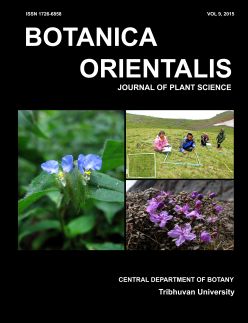Rhododendron species richness patterns and impacts of global warming on its distribution in Central Himalayas, Nepal
DOI:
https://doi.org/10.3126/botor.v9i0.21009Keywords:
Distribution range, global warming, unimodal, vegetation, vulnerableAbstract
Global warming and climate change have caused devastating impacts on biological diversity especially in northern latitude and altitude. Evaluation of species richness patterns and range size distribution is crucial for the conservation and management of biological diversity. As Rhododendron species generally grow in the higher latitude and altitude their study on range size distribution may help to predict the future fate of species against presumed global warming in the Himalayas. This study relates the distribution range of Rhododendron species and the potential impacts of global warming and climate change on it. The distribution range varied from 100 to 2600 m along the Himalayan elevation gradient. Generally, species found at the higher elevation have longer range compared to the species found at lower elevation. Among the Rhododendron species found in Nepal Himalayas, R. epapillatum, R. trichocladum and R. virgatum have only 100 m distribution range, which are therefore most vulnerable to the shift in vegetation zones as a result of future projection of temperature rise. Other species having 300 m range of distribution are also vulnerable to different levels of temperature rise as predicted by various sources. These findings can generate hypothesis that species with shorter distribution rage are more vulnerable to climate change which can be tested quantitatively. This in turn will establish a relationship between distribution ranges of species and shift in vegetation zones, and rising temperatures in the Himalayan region due to global warming.
Botanica Orientalis – Journal of Plant Science (2015) 9: 12–19
Downloads
Downloads
Published
How to Cite
Issue
Section
License
This license enables reusers to copy and distribute the material in any medium or format in unadapted form only, for noncommercial purposes only, and only so long as attribution is given to the creator.




